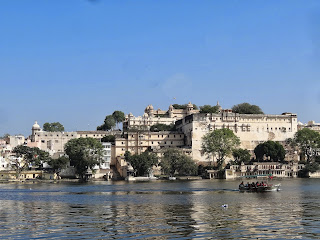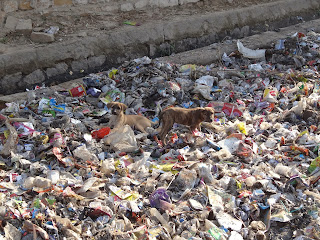In this blog, you will read about our journey into Rajasthan, the state in India that has some of the most deeply entrenched traditions and longstanding history, the most beautiful palaces and forts, and is dominated by the Great Thar Desert. The journey actually began in the last blog, in Pushkar (wasn’t it a cracker?), and continues here in Udaipur, the “most romantic city in India” according to Lonely Planet. We spent a relaxing couple of days here with our third and fourth wheels, Alex and Ben (just kidding guys, we miss ya!).
The City Palace, built over hundreds of years by several different Maharajas – all of whom clearly had very luxurious taste in living space.
If you've got the money and slave-power to build floating palaces, then, why not?
The inside of the City Palace is ridiculously nice. Mosaics and carvings cover almost every aspect of the walls and ceilings. And, in case the Maharajas ran out of nice things to look at, it has some exquisite views over Lake Pichola.
Next we headed to Jaisalmer, a pretty unique place even by Indian standards. Entirely surrounded by desert, Jaisalmer is essentially just a big sandstone fort rising out of the sand, with sandstone houses scattered around the base of the fort. With every building here being the colour of golden sand, it blends perfectly into the desert. It seemed a shame to come as far as Jaisalmer and not go on a camel-trek into the Thar, so that is exactly what we did. Led by our camel-driver Abeh, a self-proclaimed desert man and camel college graduate, we headed deep into the Great Thar Desert to spend a night under the stars.
The World's biggest sandcastle? Wandering through the narrow streets is a bit of a maze, the majority of the fort is filled with hotels, street sellers and cows (always cows)...
Most street vendors take an enthusiastic approach and accost every single tourist who passes by, laboriously listing all the items which they sell in their "verrry cheap, verrry best shop". This guy's just like "yo."
The not so nice side of India, sadly, is everywhere...
After purchasing mandatory camel-patterned sunhats, the ones with the neck flaps, we loaded up our camels and headed into the Thar. Just us, 5 camels and Abeh.
Abeh the Desert Man. This guy was born and raised in the sands of the Thar, and has never left them. He commands a herd of camels, cooks a mean curry, and is an all-round pleasant fellow.
"No worry no hurry, no chicken no curry!"
Surprisingly this was one of the most comfortable places we slept in, in India. We were lucky that the jackals spared us.
One of Abeh's spontaneous wake-up shots (little bit creepy?). Felix nails the I-just-woke-up-in-the-desert look.
After a tearful farewell to our two travel companions, we continued on to Jodhpur, the ‘Blue City’ of Rajasthan. Dominated by the outrageously enormous Mehrangarh Fort on a hill in the centre of the city, the city extends around it in a giant mess of blue and white lego. Hidden away in the jumble of houses are countless bazaars, packed with the usual food stalls, fabric shops, jewelers, temples, auto-rickshaws, dogs, cows and people.
The colossal Mehrangarh Fort, surely the most impressive fort we've seen in India. Never once breached by any enemy, we'll have you know. We learnt that from the free-audio guide, go us.
Phoebe trying to relive the glory days, before she was escorted out of the fort.
What's that, we hear you say? That, friends, is what makes Jodhpur famous - the messy jumble of blue cubic houses. Fun fact: Traditionally the Brahmin caste (the highest class in the Hindu belief system) added indigo to their house paint, to keep the houses cooler in the desert sun and to keep the insects away. Ta-da!
People have started taking the tourist-snapping trend to new levels. Forcing tourists to hold your baby while you take a photo is a bit weird. Almost as weird as when they try to hold your hand and take photos..
Next time: Delhi, Bangkok......... Home :) :(



















Super
ReplyDelete